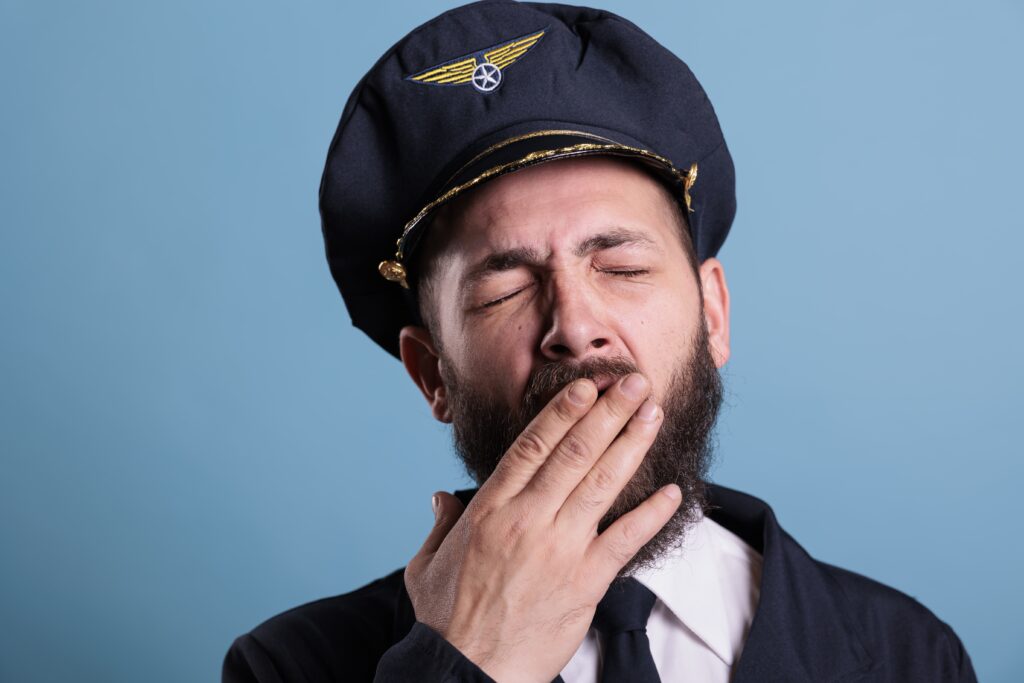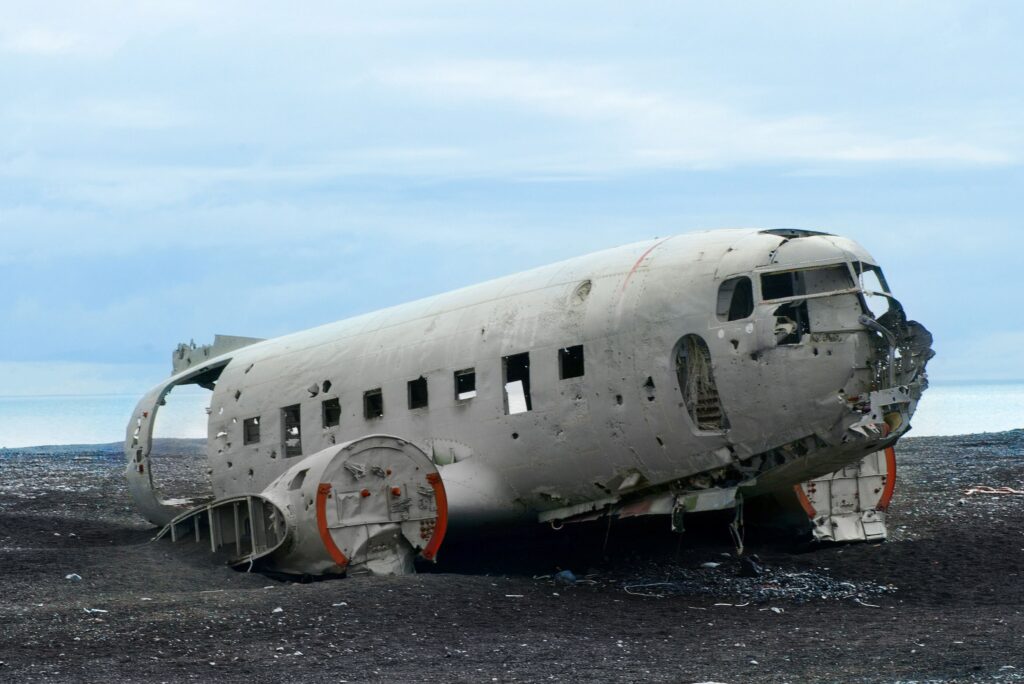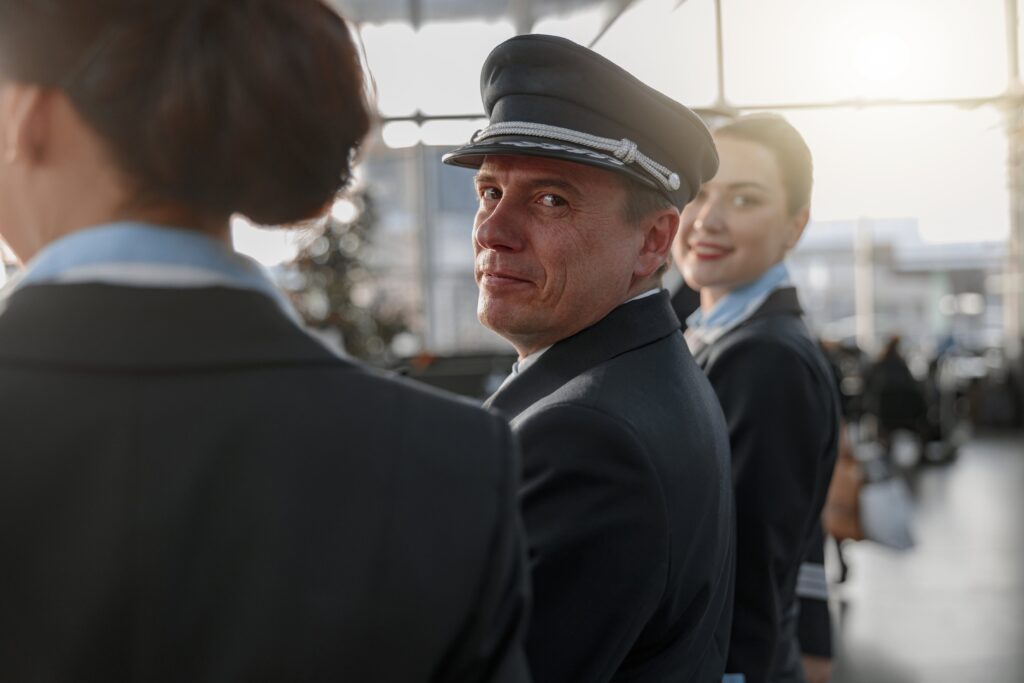
Before diving headfirst into the dangers of pilot fatigue, we’ll start where most fall off.
While we tend to nod when anyone mentions the word fatigue – do we really understand what it means to be fatigued?
Visiting the coffee machine once or thrice, contemplating when you’ll see your beloved futon, or feeling your eyelids are about the same weight as the Statue of Liberty does not mean you are fatigued. (*although all evidence suggests that you should go home and grab a nab as soon as possible).
When we talk about being fatigued, we are, in fact, discussing something much more severe than simply needing a good night’s sleep.
The International Civil Aviation Organization (ICAO) defines fatigue as “a physiological state of reduced mental or physical performance capability resulting from sleep loss or extended wakefulness, circadian phase, or workload (mental and/or physical activity) that can impact a crew member’s alertness and ability to safely operate an aircraft or perform safety-related duties.”
Having a fatigued pilot means that from the moment they walk into the aircraft until the moment they leave, they won’t be able to do their duties effectively.
And while aviation accidents are rare, when they occur, 80% result from human error, and out of those, 15-20% are caused by pilot fatigue.
Surprised?
In a British Airline Pilots’ Association survey, 56% of the 500 participants said they had involuntarily fallen asleep in the cockpit. Of those, 29% said they woke to find the other pilot asleep.
Discover all our aviation-related topics.

You might recall a time when you were driving home from a dinner party late in the evening. The hours before the dinner party, you spent making that deadline and replying to your coworker’s hundreds of emails, all with minimum rest because your two-year-old couldn’t sleep the night before. So, you’re driving home after a long day and even longer night, and your eyes are harder to keep open than Fort Knox. You then try to remember – was it green, or did I just run a red light? All while you do your absolute best to keep the car straight on the road.
A scenario that seems familiar?
Now imagine you’re up in the air flying an aircraft. While this might come as a shock to a lot of people, pilots do live normal lives. They have annoying coworkers, babies that won’t fall asleep and friends who like to host dinner parties. Now, add to that list unpredictable work hours, long duty hours, circadian disruption, insufficient sleep, changing check-in times, jetlag, etc.
Pilots suffer fatigue for reasons different from “normal” people. The nature of their job involves north/south or east/west travel (or some combination of the two), often for great distances and times, combined with workload and scheduling issues. This puts them at risk for some problems caused by fatigue that most non-pilots never face.
The fact is that fatigue is particularly prevalent among pilots.
Now, think back to the driving example, and you might understand why pilot fatigue poses a real threat in the transport industry.
To paint the picture – let’s go through some aviation accidents and incidents where pilot fatigue was a primary contributor.

The pilots ignored the minimum decision height at Coventry Airport and hit an electricity pylon. This caused the aircraft to roll and hit the ground inverted. All 5 crew members onboard died.
Reported causes: “The performance of the flight crew was impaired by the effects of tiredness, having completed over 10 hours of flight duty through the night during five flight sectors, which included a total of six approaches to land.”
Source: Department of Transport, 1994
The pilots departed from Berlin airport and crashed after they descended below the minimum descent altitude and struck trees.
Reported causes: “The flight crew deliberately continued the descent under instrument flight conditions below the minimum altitude for the approach without having the necessary prerequisites. The flight crew initiated the go-around too late (…). The Commander’s ability to concentrate and take appropriate decisions, as well as his ability to analyse complex processes, were adversely affected by fatigue.”
Source: Federal Department of Environment, Transport, Energy and Communications, 2001
A flight from Halifax airport crashed shortly after take-off when the aircraft hit an earthen berm while heading for Spain. The aircraft tail detached, and the rest crashed after flying another thousand feet.
Reported causes: “Crew fatigue likely increased the probability of error during calculation of the take-off performance data and degraded the flight crew’s ability to detect this error. Crew fatigue, combined with the dark take-off environment, likely contributed to a loss of situational awareness during the take-off roll. Consequently, the crew did not recognise the inadequate take-off performance until the aircraft was beyond the point where the take-off could be safely conducted or safely abandoned.”
Source: Transportation Safety Board of Canada
Scheduled to depart from Stockholm and arrive in Dubai. The pilots began taxiing before receiving clearance, struck a tow vehicle, and continued taxiing for another 150 meters. There were no causalities or injuries. The pilots had been awake for 18-20 hours, and the incident occurred at 3.30 a.m.
Reported causes: “Inadequate checklists for the pilots in respect of checking that an all-clear signal had been received; a probable contribution was that stress and fatigue factors limited the concentration abilities of the pilots.”
Source: Swedish Accident Investigation Board, 2008
While en route to Buffalo International Airport, the aircraft began to stall. The pilots reacted by pulling instead of pushing on the plane’s control column. The aircraft crashed into a house, killing a man and all 49 occupants onboard. Neither pilot recognised that the plane was slowing down too quickly, and neither pilot reacted adequately.
Reported causes: “Inadequate training, unnecessary conversation amongst aircrew during take-off and landing, pilot flying after failing proficiency tests, fatigue. Both pilots had long commutes and slept in the crew lounge instead of a hotel before the fight.”
Source: NTSB, 2009
So, the question on everybody’s mind; how can we reduce pilot fatigue?

Regulatory bodies such as ICAO and EASA have installed flight time limitations to ensure aircrew have enough time to rest before a flight. It also ensures that the airline can only schedule up to x hours of flight duty.
But – is that enough?
We still see accidents happening because pilots are fatigued.
Factors such as the inability to sleep at a new hotel, worries about a simulator training pass, jetlag, etc., can easily contribute to pilots becoming fatigued. Factors that regulatory bodies cannot consider.
So, what’s the solution, really?
For the industry to avoid accidents or incidents related to pilot fatigue, we must also endorse action from the pilots. Pilots must recognise and understand the dangers of fatigue and report unfit for duty.
Of course, doing that is much easier said than done.
During CRM courses and Human Performance and Limitations courses, we visit the topic of fatigue and examines pilots’ attitude towards fatigue.
The topic often generates frustration that neither the airline nor the authorities understand the tiredness and disruption caused by tight schedules and shift work.
But do the crews themselves understand the implications of fatigue?
Everyone agrees that fatigue is dangerous and wishes authorities and employers to take the issues of fatigue seriously.
Meanwhile, when we ask pilots:
“Even when fatigued, I perform effectively during critical times of flight.”
We get mixed responses.
We offer pilots a choice of five different answers:
A = I agree
B = I agree slightly
C = I am neutral
D = I disagree slightly
E = I disagree
Often, we see 70% on D and E and the rest on A, B and C.
A study from 1988 to 1994 depicts a decreasing number of pilots agreeing to perform effectively even when fatigued (answer A). While 1994 was a long time ago, we continue to face challenges regarding the attitude towards fatigue.
So, we present the pilots with some facts.
A study conducted by the Adelaide Centre for Sleep Research had this to say about fatigue:
So, we ask again:
“Even when fatigued, I perform effectively during critical times of flight.”
Despite presenting the above facts, we still experience that around 30% of students will answer A, B or C.
So, we try again but change the question slightly:
“Even when influenced by alcohol, I perform effectively during critical times of flight.”
To no one’s surprise, everyone tends to change their answers to E.
But, thinking back to the study from Adelaide – what is really the difference?
While different things might trigger the two, they impact operational safety similarly.

One insidious aspects of fatigue is the inability to recognise one’s own level of impairment and take appropriate action. We have experienced numerous examples during training that even trained aircrews have yet to fully accept this.
Our aim is, of course, to achieve awareness in the individual about the effects of fatigue. In aviation, we are not looking for superheroes who have high thoughts about themselves and their abilities when fatigued. We are looking for people with a realistic and self-conscious attitude to safety and themselves.
To reduce pilot fatigue, we cannot keep looking at the regulators to be our knight in shining armour – we need to endorse a change in pilots’ attitudes toward their own capabilities.
Dive into our insightful and informative articles that will help you explore more and get ahead of the competition.
© 2024 NaviMinds – Designed by Aveo web&marketing